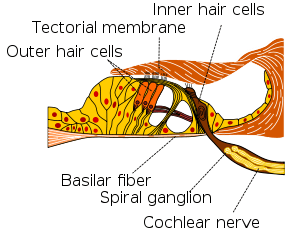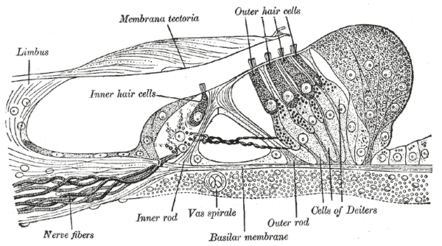Tectorial membrane
| Tectorial membrane (cochlea) | |
|---|---|
 Section through the spiral organ of Corti. (Membrana tectoria labeled at center top.) | |
 Section through the spiral organ of Corti. (Membrana tectoria labeled at center top.) | |
| Details | |
| Identifiers | |
| Latin | membrana tectoria ductus cochlearis |
| MeSH | A09.246.631.246.292.906 |
| TA | A15.3.03.108 |
The tectorial membrane (TM) is one of two acellular membranes in the cochlea of the inner ear, the other being the basilar membrane (BM). The TM is located above the spiral limbus and the spiral organ of Corti and extends along the longitudinal length of the cochlea parallel to the BM. Radially the TM is divided into three zones, the limbal, middle and marginal zones. Of these the limbal zone is the thinnest (transversally) and overlies the auditory teeth of Huschke with its inside edge attached to the spiral limbus. The marginal zone is the thickest (transversally) and is divided from the middle zone by Hensen's Stripe. It overlies the sensory inner hair cells and electrically-motile outer hair cells of the organ of Corti and during acoustic stimulation stimulates the inner hair cells through fluid coupling, and the outer hair cells via direct connection to their tallest stereocilia.
Structure
The TM is a gel-like structure containing 97% water. Its dry weight is composed of collagen (50%), non-collagenous glycoproteins (25%) and proteoglycans (25%).[1] Three inner-ear specific glycoproteins are expressed in the TM, α-tectorin, β-tectorin and otogelin. Of these proteins α-tectorin and β-tectorin form the striated sheet matrix that regularly organises the collagen fibres. Due to the increased structural complexity of the TM relative to other acellular gels (such as the otolithic membranes),[2][3] its mechanical properties are consequently significantly more complex.[4] They have been experimentally shown to be radially and longitudinally anisotropic[5][6] and to exhibit viscoelastic[7][8] properties.
Function
The mechanical role of the tectorial membrane in hearing is yet to be fully understood, and traditionally was neglected or downplayed in many models of the cochlea. However, recent genetic[9][10][11] , mechanical[7][8][12] and mathematical[13] studies have highlighted the importance of the TM for healthy auditory function in mammals. Mice that lack expression of individual glycoproteins exhibit hearing abnormalities, including, most notably, enhanced frequency selectivity in Tecb−/− mice,[11] which lack expression of β-tectorin. In vitro investigations of the mechanical properties of the TM have demonstrated the ability of isolated sections of TM to support travelling waves at acoustically relevant frequencies. This raises the possibility that the TM may be involved in the longitudinal propagation of energy in the intact cochlea.[13]
Additional images
 Floor of ductus cochlearis.
Floor of ductus cochlearis. Cross αsection of the cochlea.
Cross αsection of the cochlea.
Notes
- ↑ Thalmann, I.; Thallinger, G.; Comegys, T.H.; Thalmann, R. (1986). "Collagen – The Predominant Protein of the Tectorial Membrane". ORL. 48 (2): 107–115. doi:10.1159/000275855. ISSN 1423-0275.
- ↑ Goodyear, Richard J.; Richardson, Guy P. (2002). "Extracellular matrices associated with the apical surfaces of sensory epithelia in the inner ear: Molecular and structural diversity". Journal of Neurobiology. 53 (2): 212–227. doi:10.1002/neu.10097. ISSN 0022-3034.
- ↑ Freeman, Dennis M.; Masaki, Kinuko; McAllister, Abraham R.; Wei, Jesse L.; Weiss, Thomas F. (2003). "Static material properties of the tectorial membrane: a summary". Hearing Research. 180 (1-2): 11–27. doi:10.1016/S0378-5955(03)00072-8. ISSN 0378-5955.
- ↑ Freeman, Dennis M.; Abnet, C.Cameron; Hemmert, Werner; Tsai, Betty S.; Weiss, Thomas F. (2003). "Dynamic material properties of the tectorial membrane: a summary". Hearing Research. 180 (1-2): 1–10. doi:10.1016/S0378-5955(03)00073-X. ISSN 0378-5955.
- ↑ Richter, C; Emadi, G; Getnick, G; Quesnel, A; Dallos, P (2007). "Tectorial Membrane Stiffness Gradients☆". Biophysical Journal. 93 (6): 2265–2276. doi:10.1529/biophysj.106.094474. ISSN 0006-3495.
- ↑ Gueta, R.; Barlam, D.; Shneck, R. Z.; Rousso, I. (2006). "Measurement of the mechanical properties of isolated tectorial membrane using atomic force microscopy". Proceedings of the National Academy of Sciences. 103 (40): 14790–14795. doi:10.1073/pnas.0603429103. ISSN 0027-8424.
- 1 2 Ghaffari, R.; Aranyosi, A. J.; Freeman, D. M. (2007). "Longitudinally propagating traveling waves of the mammalian tectorial membrane". Proceedings of the National Academy of Sciences. 104 (42): 16510–16515. doi:10.1073/pnas.0703665104. ISSN 0027-8424.
- 1 2 Jones, Gareth; Russell, Ian; Lukashkin, Andrei; Shera, Christopher A.; Olson, Elizabeth S. (2011). "Laser Interferometer Measurements of the Viscoelastic Properties of Tectorial Membrane Mutants": 419–420. doi:10.1063/1.3658122. ISSN 0094-243X.
- ↑ Legan, P.Kevin; Lukashkina, Victoria A.; Goodyear, Richard J.; Kössl, Manfred; Russell, Ian J.; Richardson, Guy P. (2000). "A Targeted Deletion in α-Tectorin Reveals that the Tectorial Membrane Is Required for the Gain and Timing of Cochlear Feedback". Neuron. 28 (1): 273–285. doi:10.1016/S0896-6273(00)00102-1. ISSN 0896-6273.
- ↑ Legan, P Kevin; Lukashkina, Victoria A; Goodyear, Richard J; Lukashkin, Andrei N; Verhoeven, Kristien; Van Camp, Guy; Russell, Ian J; Richardson, Guy P (2005). "A deafness mutation isolates a second role for the tectorial membrane in hearing". Nature Neuroscience. 8 (8): 1035–1042. doi:10.1038/nn1496. ISSN 1097-6256.
- 1 2 Russell, Ian J; Legan, P Kevin; Lukashkina, Victoria A; Lukashkin, Andrei N; Goodyear, Richard J; Richardson, Guy P (2007). "Sharpened cochlear tuning in a mouse with a genetically modified tectorial membrane". Nature Neuroscience. 10 (2): 215–223. doi:10.1038/nn1828. ISSN 1097-6256.
- ↑ Ghaffari, Roozbeh; Aranyosi, Alexander J.; Richardson, Guy P.; Freeman, Dennis M. (2010). "Tectorial membrane travelling waves underlie abnormal hearing in Tectb mutant mice". Nature Communications. 1. doi:10.1038/ncomms1094. ISSN 2041-1723.
- 1 2 Meaud, Julien; Grosh, Karl (2010). "The effect of tectorial membrane and basilar membrane longitudinal coupling in cochlear mechanics". The Journal of the Acoustical Society of America. 127 (3): 1411. doi:10.1121/1.3290995. ISSN 0001-4966.
External links
- Diagram at une.edu
- Animation at bioanim.com
- Histology at KUMC eye_ear-ear03